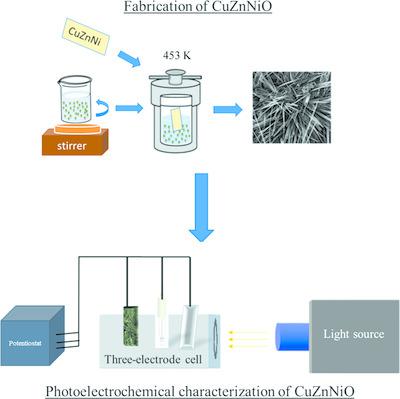当前位置:
X-MOL 学术
›
J. Appl. Crystallogr.
›
论文详情
Our official English website, www.x-mol.net, welcomes your feedback! (Note: you will need to create a separate account there.)
One‐step synthesis of novel Cu2ZnNiO3 complex oxide nanowires with tuned band gap for photoelectrochemical water splitting
Journal of Applied Crystallography ( IF 6.1 ) Pub Date : 2020-10-13 , DOI: 10.1107/s1600576720012200 Aya Amin , Ali El-dissouky
Journal of Applied Crystallography ( IF 6.1 ) Pub Date : 2020-10-13 , DOI: 10.1107/s1600576720012200 Aya Amin , Ali El-dissouky

|
Although alloying and nanostructuring offer a great opportunity for enhancing photoelectrochemical behavior and band gap tuning, these methods have not been investigated extensively. This article reports the synthesis of Cu2ZnNiO3 complex oxide nanowires (∼200 nm) grown on German silver alloy via a one‐step optimized hydrothermal route and their utilization to split water photoelectrochemically. Surface characterizations were used to elucidate the formation mechanism of the Cu2ZnNiO3 complex oxide nanowires. The nanowires exhibited an exceptional visible light absorption extending from 400 to 1400 nm wavelengths with a tuned band gap of ∼2.88 eV calculated from the corresponding Tauc plot. In tests to split water photoelectrochemically, the nanowires generated a significant photocurrent of up to −2.5 mA cm−2 at −0.8 V versus Ag/AgCl and exhibited an exceptional photostability which exceeded 2 h under light‐off conditions with no photocurrent decay. Band edge positions related to water redox potentials were estimated via Mott–Schottky and diffuse reflectance spectroscopy analysis with the density of charge carriers reaching as high as 5.15 × 1018 cm−3. Moreover, the nanowires generated ∼1100 µmol of H2 in 5 h. These photoelectrochemical results are much higher than the reported values for similar structures of copper oxide, zinc oxide and nickel oxide separately under the same conditions, which can be attributed to the advantages of Cu, Zn and Ni oxides (such as visible light absorption, photostability, and efficient charge carrier generation and transport) being combined in one single material. These promising results make German silver a robust material toward photoelectrochemical water splitting.
中文翻译:

光化学能分解带隙的新型Cu2ZnNiO3复合氧化物纳米线的一步合成
尽管合金化和纳米结构化为增强光电化学行为和带隙调节提供了巨大的机会,但这些方法尚未得到广泛研究。本文报道了通过一步优化水热法在德国银合金上生长的Cu 2 ZnNiO 3复合氧化物纳米线(〜200 nm)的合成及其在光电化学分解水中的利用。使用表面表征来阐明Cu 2 ZnNiO 3的形成机理复合氧化物纳米线。纳米线表现出出色的可见光吸收,其吸收波长范围从400到1400 nm,根据相应的Tauc图计算得出的调谐带隙为〜2.88 eV。在通过光化学方法分解水的测试中,纳米线在相对于Ag / AgCl的-0.8 V电压下产生了高达-2.5 mA cm -2的显着光电流,并表现出优异的光稳定性,在起燃条件下超过2 h且无光电流衰减。通过Mott–Schottky和漫反射光谱分析法估计了与水氧化还原电位相关的能带边缘位置,电荷载流子的密度高达5.15×10 18 cm -3。此外,纳米线可产生约1100 µmol的H 2在5小时内 这些光电化学结果远高于相同条件下铜,锌和镍的相似结构的报道值,这可以归因于铜,锌和镍的氧化物的优势(例如可见光吸收,光稳定性)。 ,以及高效的电荷载流子生成和传输)组合在一种材料中。这些有希望的结果使德国银成为抗光电化学水分解的强大材料。
更新日期:2020-12-03
中文翻译:

光化学能分解带隙的新型Cu2ZnNiO3复合氧化物纳米线的一步合成
尽管合金化和纳米结构化为增强光电化学行为和带隙调节提供了巨大的机会,但这些方法尚未得到广泛研究。本文报道了通过一步优化水热法在德国银合金上生长的Cu 2 ZnNiO 3复合氧化物纳米线(〜200 nm)的合成及其在光电化学分解水中的利用。使用表面表征来阐明Cu 2 ZnNiO 3的形成机理复合氧化物纳米线。纳米线表现出出色的可见光吸收,其吸收波长范围从400到1400 nm,根据相应的Tauc图计算得出的调谐带隙为〜2.88 eV。在通过光化学方法分解水的测试中,纳米线在相对于Ag / AgCl的-0.8 V电压下产生了高达-2.5 mA cm -2的显着光电流,并表现出优异的光稳定性,在起燃条件下超过2 h且无光电流衰减。通过Mott–Schottky和漫反射光谱分析法估计了与水氧化还原电位相关的能带边缘位置,电荷载流子的密度高达5.15×10 18 cm -3。此外,纳米线可产生约1100 µmol的H 2在5小时内 这些光电化学结果远高于相同条件下铜,锌和镍的相似结构的报道值,这可以归因于铜,锌和镍的氧化物的优势(例如可见光吸收,光稳定性)。 ,以及高效的电荷载流子生成和传输)组合在一种材料中。这些有希望的结果使德国银成为抗光电化学水分解的强大材料。

























 京公网安备 11010802027423号
京公网安备 11010802027423号